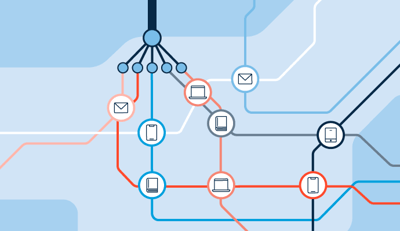October 31, 2019
 by Marilia Dimitriou / October 31, 2019
by Marilia Dimitriou / October 31, 2019

Customer experience has become one of the most important factors that determine the long-term engagement and success of a business.
Compared to the customer of the past, modern consumers bounce between different channels when they want to purchase an item.
To respond to this rapid change in customer behavior, brands have started to adopt a customer-centric omnichannel marketing strategy that requires you to be the problem-solver of your customers’ pain points.
As great customer experience has become the main reason for a customer's continuous interaction with a brand, your channels should be able to adapt to your customers’ behavior and needs, especially when they are ready to take a huge step further down their marketing journey.
What’s more, your channels should deliver content that will be tailored to your customer's needs and give actual solutions instead of promoting your product for the sake of profit.
Now, you may be a little skeptical about this omnichannel approach. Isn’t making a profit our primary business goal? Why don’t we find more customers to buy from our store? The truth is that getting more customers to buy from you isn’t always the best practice to promote your success. The right way to succeed long term is to nurture repeat buyers who will support you throughout their journey.
According to Keven Richards, “once those buyers experience what makes you special, repeat buyers will come directly to you for expanded inventory options and a customized buying experience. Omnichannel marketing is a key component to eCommerce success (and world domination).”
If we take a look at the numbers, we’ll see that customer retention and customer engagement rates are 90% and 18.86% higher for omnichannel marketing respectively.
So, by prioritizing customer retention over one-time purchases, you get a loyal audience that won’t abandon you after a single purchase and contribute to the continuous growth of your e-commerce business.
With customer retention being one of the most important factors that lead e-commerce businesses to greatness, omnichannel marketing is a powerful weapon to fulfill your customers' needs and give them a qualitative B2C exchange that will lead to a deeper experience.
Omnichannel marketing is the cross-channel content approach that aims at giving customers a seamless customer experience.
Here’s a great definition from Shopify:
“[Omnichannel marketing] is about communicating in ways that are aligned with why they use a given channel and showing awareness of their individual stage in the customer lifecycle. Customers can purchase wherever they are—rather than treating channels as independent silos, omnichannel accounts for the spillover between channels and offers customer experiences within and between channels.”
As a strategy that puts your customers at the core of your operations, you have to stay truthful to the customer-centric approach and create engaging content that will give them solutions.
Here’s a great depiction of omnichannel marketing from G2:
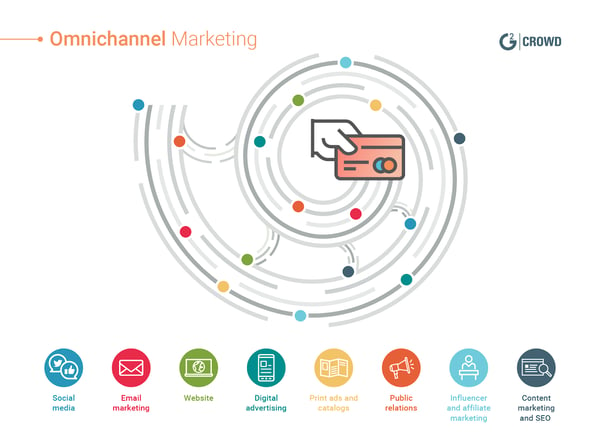
By breaking down silos between channels, omnichannel marketing can deliver an experience that is the same regardless of channel. As the core of your strategy, your marketing channels should be able to cooperate efficiently and exchange valuable information to create the perfect omnichannel ecosystem.
Now, let’s see some of the most popular marketing channels that marketers use to deliver unique customer experiences, incredible offers, and powerful incentives.
Your website is your digital brick-and-mortar representative that numerous potential customers will come across when they search for products. While sometimes marketers don’t consider a brand’s website as an important marketing channel, it is, in fact, the first thing that gives your customers' a taste of what your brand is about.
Everything from your choice of background images to your copy will give visitors a hint of your brand culture. Regarding your e-commerce store’s website, you should optimize it in a way that attracts your customer's attention, doesn’t cause confusion, has simple backgrounds and looks professional.
Here’s a great example from Ab Aeterno watches:
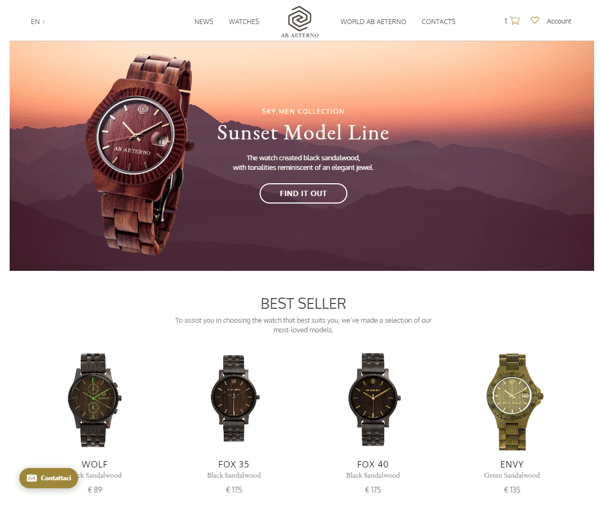
And here’s an ambiguous one from LingsCars:
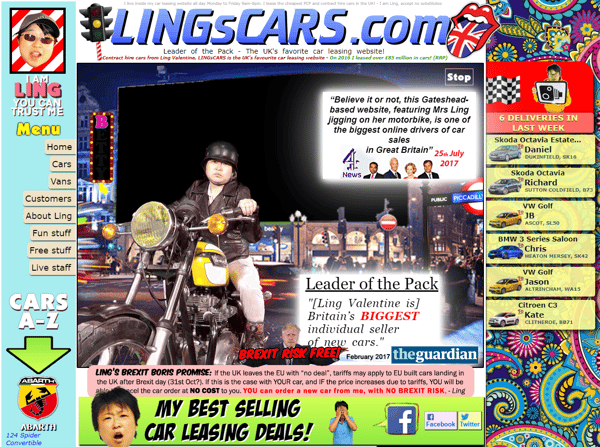
As the headquarters of your marketing strategy, your website needs to be equipped with amazing visuals, content and landing pages that will mesmerize your potential customers.
And while Lingscars’ website is a retro publicity stunt with the most hilarious meet the staff page I’ve seen so far (I’ll leave it here for your entertainment), it can cause major frustration to someone who wants to actually lease a car.
Apart from the visual elements, you should also consider improving your CRO by adding personalization to your website.
Here are some ways to get started with website personalization.
As the best cost-effective marketing channel, emails can deliver powerful incentives to your subscribers, educate them, give them reasons to buy from your store and turn them into loyal customers who will support you throughout their customer journey.
Along with marketing automation, you will be able to automate your workflows and, with the help of personalization, deliver emails that will target your customers' needs the moment they need them.
Emails are part of every successful omnichannel marketing strategy since 72% of them prefer to receive promotional content through them and have the best ROI out there ($38 for each $1 spent).
Here’s a great example from Bellami Hair:
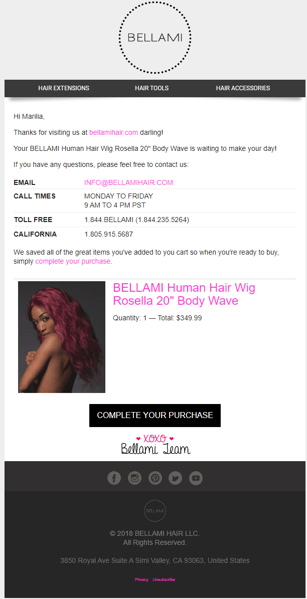
For you, social media networks are a precious ally that can boost your engagement and skyrocket your brand awareness. When your e-commerce business expands its social media reach, your customers get another channel to find information about you and your products.
Through your social media posts, you’ll give your customers a new perspective of your products, useful tips, and sneak peeks that will excite them. What's more, instead of responding to comments, you can use Facebook’s Messenger and Twitter and Instagram’s direct messages to give your customers’ a direct channel to ask questions and receive information.
Our mobile phones are to us what the all-powerful Mjolnir is to Thor.
Smartphones easily remained the most favored mobile device among US consumers, growing 3 percent and reaching 85 percent penetration overall. According to Deloitte’s Global Mobile Consumer Survey in the US, smartphones are the most favored mobile device with an 85% penetration overall and a viewing frequency that reaches 52 times per day.
Since people can’t spend a day without interacting with their phones, targeting your audience through mobile apps is one of your smartest moves.
Mobile apps, now, can deliver special product recommendations, in-app messaging, and links that will be tailored to customers’ needs and deliver a better customer experience. Including mobile apps in your omnichannel strategy will help you improve your customers’ desktop experience and allow them to continue their shopping experience regardless of device.
Also, mobile gives you the chance to engage your customers through push notifications. As the best real-time engagement tool, mobile push notifications should be carefully personalized and sent to the right person at the right moment.
If you think that Green Arrow and Hawkeye are the same person belonging to the same company, then, boy, we have a lot to talk about! While I’d love to discuss how they are completely different characters with just a few (or maybe a lot!) similarities, I’m more interested in helping you understand that omnichannel and multichannel marketing have completely different approaches.
As we said, when we talk about omnichannel marketing, the focus of marketing becomes the focus of your business, and your end goal is the delivery of a seamless customer experience. When it comes to multichannel marketing, though, the business itself becomes the center of focus, delivering the same message across all channels.
Here’s a depiction of multichannel marketing:
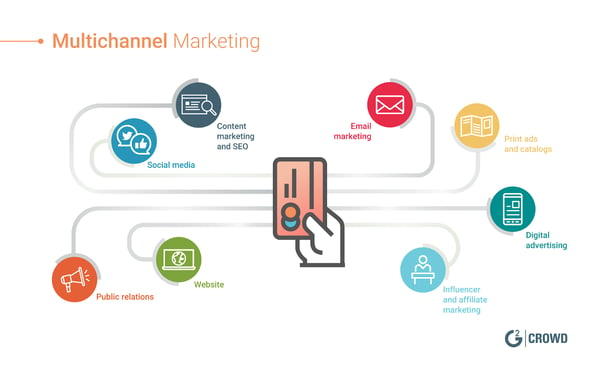
For instance, a brick-and-mortar store may also have an e-commerce store online. The brick-and-mortar store might have its own stock and operations. Similarly, the e-commerce store may be completely independent and even has its own policies, stock, and tactics.
Now, if a customer buys something online they might not be able to return it in-store because the online and offline presence of the same store is completely different. Compared to omnichannel marketing where the experience is seamless, multichannel marketing gives customers’ a very different online and offline experience of the same business.
Follow these steps for the perfect omnichannel strategy.
As one of the most important factors in building your omnichannel marketing strategy, personalization is the force that will allow your eCommerce business to deliver more consistent and continuous messages. The first thing you should do to power it up is to find a great landing page builder and create conversion-friendly lead-capture landing pages.
Since your goal should be the delivery of a seamless customer experience across all channels, your main goal is to fulfill their needs through exceptional content that will make them feel appreciated and cared for by their favorite brand.
Here’s how you can get started with personalization and customer data analysis for effective success of your campaign.
Segmentation is the most important step you must take when you want to deliver content that will truly speak to your customers. The easiest way is to segment your email subscribers into smaller groups according to set criteria that will let you manage them more efficiently.
Through email segmentation, you can give your subscribers content that will correspond to their age, gender, geographical location, and purchase history. After dividing them into segments you can send emails that will be highly personalized instead of a generic mass message that will probably go unnoticed.
To collect your subscribers’ information, you can create detailed sign-up forms where they will choose their preferences.
Here’s an efficient lead capture form from Topshop:
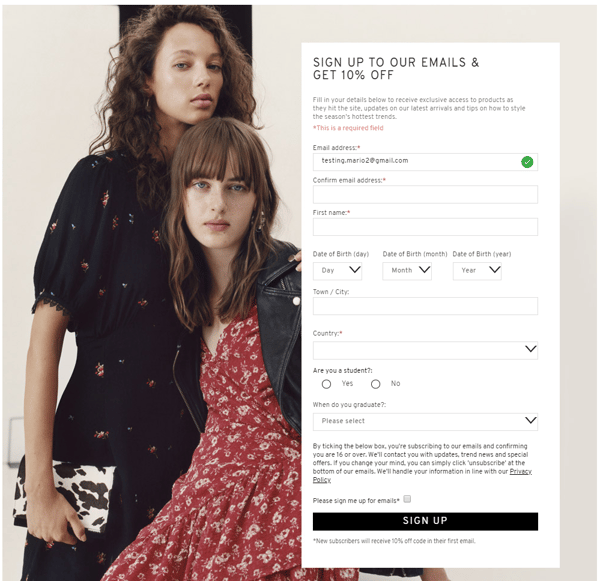
By capturing your audience’s information and preferences, you will be able to create accurate customer profiles to optimize your content.
Subject lines or the front face of your emails can determine the open, click-through and conversion rate of your email campaigns. They are, undoubtedly, what your email subscribers will see when they check their inbox.
Let’s take a look at my inbox, shall we?

Notice how IKEA uses personalization to deliver its clothes storage solutions to their subscriber? The brand tells me that this is no random storage solution, but what I’ve been looking for all along.
By shifting the focus of your subject lines to your recipient you can deliver incredible “impression triggers” that will attract attention and improve your customer’s experience with your emails.
What you want to achieve with your email is to make your customer go from maybe I need it to let me have it right now! Sending emails with personalized subject lines through an email marketing platform will also give you access to open and click-through rate tracking and analytics that will contribute to your customer analysis and help you determine what works and what not for your customers.
Personalization, your all-mighty ally to win your customers’ favor, can be also applied to the body of your emails, SMS or posts to deliver an excellent experience.
Let’s see an SMS example from Starbucks to understand more:
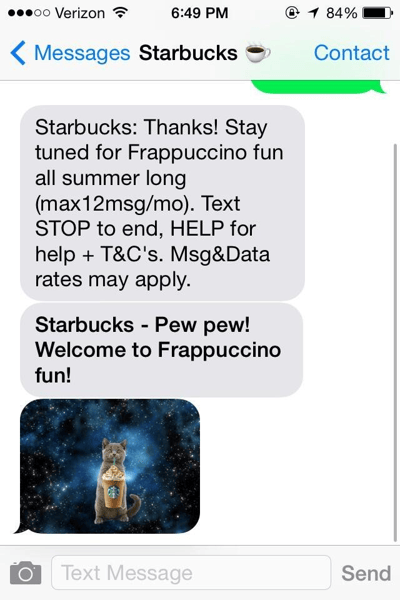
Not only does Starbucks deliver a funny text, but it also drops the sales-y and company-centric approach to please the recipient and engage those who don’t use their mobile app.
Regardless of channel, your customers need to see something interesting that will make their day, lead them to a call-to-action and deliver a great experience.
Netflix, for instance, uses personalization to target their subscribers instead of sending generic emails to promote their huge collection of movies and TV series.
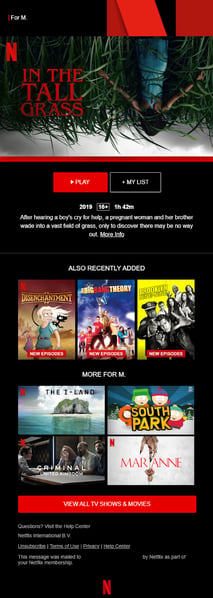
Netflix’s email is based on your interaction with their website, meaning that instead of receiving random movie suggestion, the brand uses your watching history to deliver relevant content.
Last but not least, social media ads are a major player in your omnichannel marketing strategy. As a paid search channel, you should come up with exceptional content to make the most out of it without letting your budget go in vain.
By giving your social media followers ads that include the product they searched on your website will incentivize them to go back and if they are ready to make a purchase.
Here’s my social media ad journey from HappySocks.
The ad appeared on my Instagram feed while I was checking some posts from H&M.
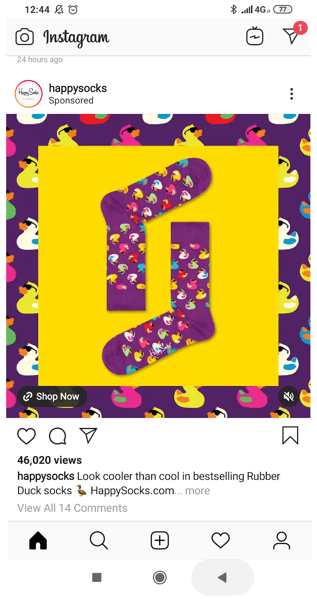
Out of curiosity, I checked their website and some hours later, while on Tumblr, I got the following ad:
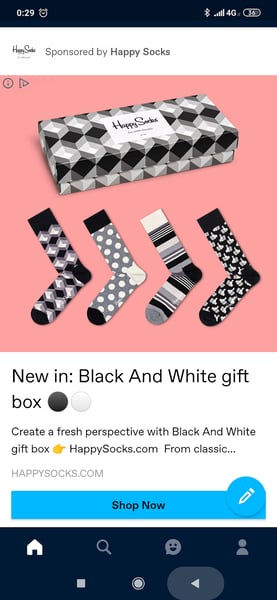
Again, I clicked on it to check the black and white collection which led to this Facebook ad:
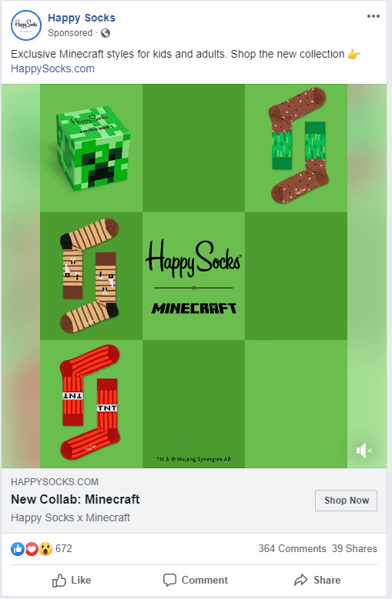
And this Messenger one:

To turn your social ads into a massive conversion tool, you shouldn’t redirect your potential customers to a generic homepage that everyone can find through a simple search, but create a landing page that will be targeted and continue the personalized experience of your social media ads.
Here’s the landing page from the HappySocks x Minecraft Facebook ad:
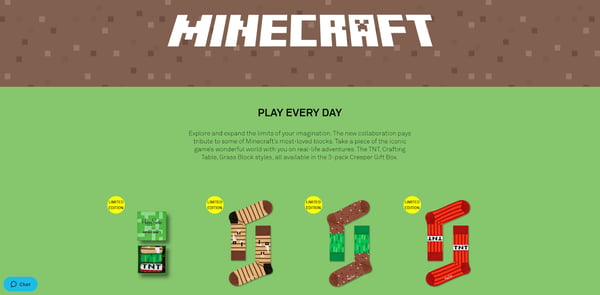
If you want to build the perfect omnichannel strategy, you must collect your potential customers’ information from one channel and use it to tailor an even more personalized experience on the next one.
Your customers are the gears of your e-commerce store, meaning that if they don’t move further down your sales funnel, your well-oiled e-commerce machine isn’t going to produce any profit.
As the core of your business, you should spend time on getting to know your customers and determine their needs, preferences and pain points, the ways they like to be contacted, how often and what may disrupt their experience with your store.
Knowing your customers can be easy. What you need to do is to talk to them throughout their journey and collect valuable information and feedback through powerful incentives and communication channels.
Understanding your audience and determining the stage they are at is very crucial in omnichannel marketing as it will allow you to deliver content that will be relevant to them and prevent you from spending time and resources on a fruitless exchange.
To make the first step toward turning your customers into the main focus of your business is to give them content, photos, social media posts and customer service that will truly speak to them.
For example, to deliver an amazing experience, Chubbies uses has a fun and fresh content approach that remains the same across all channels.
Exhibit A: Email
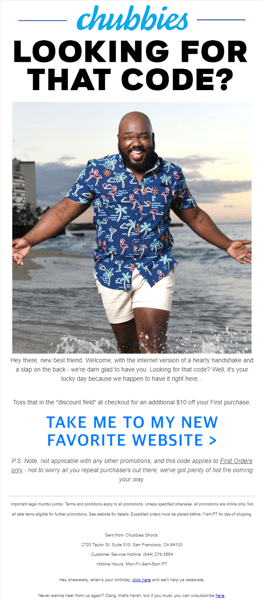
First of all, this email copy is phenomenal. Chubbies manage to keep it entertaining, friendly and with a little hilarious P.S. that reminds you of Daenerys on Christmas day.
Now, our first impression of the brand is absolutely great. Also, judging by Chubbies’ social media user comments, their target audience is very pleased with their funny and witty comments and posts.
If you check Chubbies' social media accounts as, you’ll see posts coming from the other users rather than sales-y posts that promote the brand.
Since the brand focuses on keeping customers entertained, they often come up with posts like this.
Exhibit B: Social media post

Chubbies’ fun approach is, undoubtedly, one of the cleverest omnichannel marketing strategies that focus on providing the same fun and rewarding experience across all channels.
Both their site and mobile app live up to their social media accounts expectations, simplifying their customer’s journey and, sometimes, giving them more than expected!
As for their customer service, I took it upon myself to ask them about that sweet Oktoberfest Lederhosen I saw on their website.
Exhibit C: Direct message
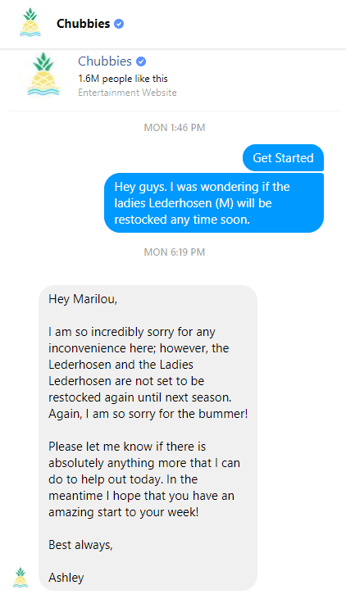
Unfortunately, I’ll have to wait until next season to buy one; however, Ashley’s excellent customer service soothed the pain of not finding a cool Lederhosen. On the plus side, the message is a lot more personal because the representative grabs the opportunity to wish me an amazing start to my week. Overall, the message is sweet, clear and has a personal touch that makes my experience with Chubbies great because it felt like they appreciated my request and cared for me.
Bonus: Package

Omnichannel marketing might incorporate various channels to reach a customer; however, it all comes down to the channels your customers will choose to contact you and not the other way round.
Whatever means of communication you choose to include in your omnichannel strategy, you should know that whether you use two or six channels, your customer considers them as one channel that delivers a seamless experience.
As we saw, there are numerous marketing channels out there that marketers use to reach their target audience.
Before choosing the best channels for your customers, though, keep in mind that when customers interact with various channels and representatives, they must feel like they communicate with a single person who knows exactly what their problems are and is willing to give them a solution.
Now that we clarified that your customers must be contacted through a unified communication front, let’s see how you can find the right channels for your eCommerce omnichannel strategy.
Your customers will always find a way to share the problems they had during their customer journey with your brand. To get started, you need to pay close attention to the channels they choose to send you messages.
For instance, Casper’s customers have commented on various Facebook posts about problems with their orders.
This isn’t the first post that Casper’s customers have used to express their issues and concerns to the brand.
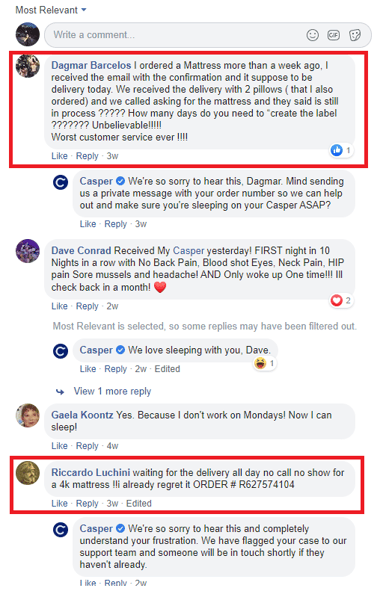
The best way to solve this problem is to create a specific Facebook chat that will answer questions about delayed orders or delivery problems. Since customers targeting your posts can give your potential customers a bad first impression, giving them a direct line of communication with your brand will improve your lead generation efforts and improve your frustrated customers’ experience.
Your marketing channels should be able to give solutions to customer pain points, answer questions and highlight how they can use a product.
For instance, if your customers reach you on social media, asking you how to use certain products or what the product looks like in real life, you can either create an Instagram channel that will give your customer stories with the product, or a Youtube channel to post how-tos and unboxing videos.
By incorporating the elements that will give customers a perfect experience, you will be able to engage them better with your business and, at the same time, show them that you value their feedback and recommendations.
To understand how mapping your customer’s journey can help you build the ultimate omnichannel strategy, let’s see a customer journey touchpoint staring our customer, Caroline:
What Caroline’s journey shows us is that when the customer is the center of our marketing strategy, we can influence them better to move a step down further our sales funnel.
Function of Beauty, the brand I used in this customer touchpoint example, gives their potential customer fully customizable and personalized experiences that start when the customer visits the website.
As it is natural, your business has different departments with very different strategies, goals and KPIs. While this each-team-for-itself strategy works well when it comes to multi-channel marketing, omnichannel marketing requires the collaboration and unity of all your teams.
To build a rock-solid omnichannel marketing strategy you first need the right person to be your omnichannel marketing coordinator. When you find them, you’ll have someone to oversee your omnichannel marketing teams, become a point of reference for them and coordinate their actions.
As a result, everyone will act as a whole and not as separate units with different content and strategies. By appointing an omnichannel strategist you make the first step towards an efficient and structured omnichannel team.
What you need to do now is to strengthen the teams’ relationships and guide them in order to get acquainted with your plan and omnichannel marketing practices. For instance, when you bring your entire company into omnichannel marketing, you should make clear that your focus will be the customer and not the brand itself.
To achieve that you need to unify your customer service representatives, email marketing and social media marketing teams.
If you want Caroline to have a seamless customer experience and enjoy her new shampoo, then you need to bring your best teams together, guide them and structure their marketing efforts around your customers.
Omnichannel marketing focuses on delivering amazing content that will give them an excellent customer experience across all channels. However, how can you be sure that your omnichannel strategy is working? Well, what you can do is to put your messages to the test through thorough A/B testing.
Since your omnichannel marketing efforts become more efficient as you collect more customer profiles and data, finding the perfect formula that can be applied to all your customers without cutting down on personalization and targeted content is a must.
The easiest way to get started is to send different messages containing different elements like subject lines, visuals, incentives, and copy.
By improving the quality and targetability of your messages, your customers will have a better experience that will drive them further down your sales funnel and even turn them into advocates who will promote your brand unconditionally.
According to Emil Kristensen, “[A/B Testing and personalization] can be combined to provide a better, more relevant experience to visitors. Which means you benefit from increased engagement, more conversions and more goodwill from your customers.”
Omnichannel marketing may sound fancy and easy to do, but if you aren’t fully committed to change the entire focus of your business to your customer, then it’ll be a lost battle.
While designing a strategy that works, especially when you are new to this kind of approach, can be difficult, we have given you the most important steps to design an omnichannel marketing strategy that will work miracles.
What you need to keep in mind is that your customers’ experience with your brand should be as seamless as possible, giving them real solutions rather than random products.
To create the perfect omnichannel strategy you need to restructure your inter- and intra-department processes to deliver a seamless customer experience that will be unaffected by boring messages and bad customer service representatives.
Explore the best eCommerce platforms with a detailed breakdown of pros and cons to find the right fit for your business
Marilia is a Creative Writer working for email marketing software Moosend. Her passion for writing has made her find new ways to combine the art of Creative Writing with SEO Copywriting. When she’s not writing articles, you’ll find her spending time on her drabbles.
Have you ever received an email mentioning that one thing you’ve been seeking for weeks? You...
 by Martina Ďurišinová
by Martina Ďurišinová
Customer experience is the new competitive ground for companies.
 by Jeff Badal
by Jeff Badal
Consistency is the key to everything.
.jpg) by Aayushi Sanghavi
by Aayushi Sanghavi
Have you ever received an email mentioning that one thing you’ve been seeking for weeks? You...
 by Martina Ďurišinová
by Martina Ďurišinová
Customer experience is the new competitive ground for companies.
 by Jeff Badal
by Jeff Badal


